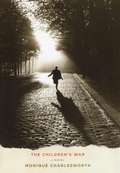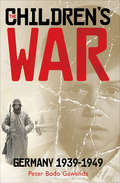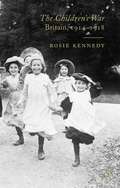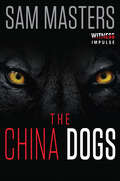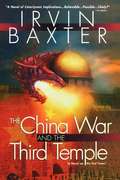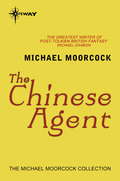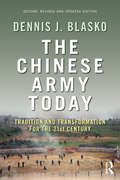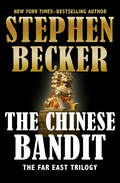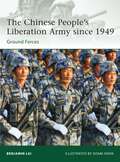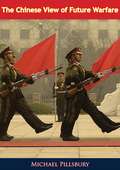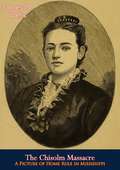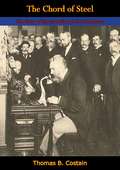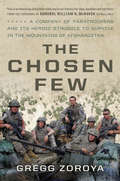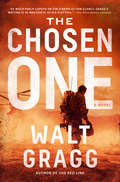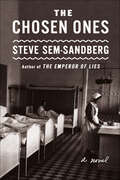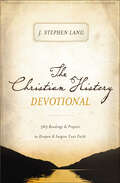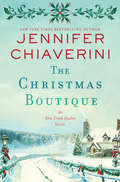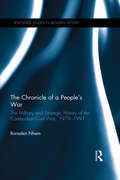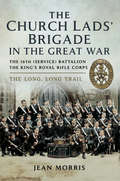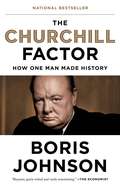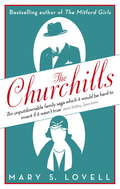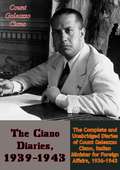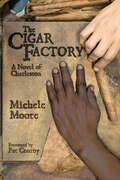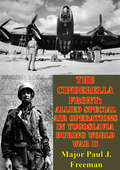- Table View
- List View
The Children's War
by Monique CharlesworthIn 1939, a girl sits in a waiting room in Marseilles. Use is half Jewish; her mother has sent her out of Germany to a place she hopes will be safe. But instead, deep into the landscape of war.
The Children's War: Germany, 1939–1949
by Peter Bodo GawendaThis true story of an innocent boy growing up in Hitler&’s Germany is &“a unique memoir…highly recommended.&”—Midwest Book Review Peter and his brothers saw the war not as military or national history, but as the adventure of everyday living. They experienced bombs dropping, soldiers occupying their home, and prisoners of war marching through the streets—all of which seemed like mere intrusions into their childhood existence. They not only survived, but thrived, during The Children's War. The strength of family ties carried the Gawenda boys through the war and shaped the author&’s perspective, making The Children's War an uplifting reading experience. Gawenda draws on his childhood in Germany during WWII to reflect the impact the war had on children. Born in the Third Reich under Hitler, Gawenda, through a child's point of view, shares his family's heartbreak, joy, humor, and cunning during their days in Oberglogau before their desperate flight from Russian conquerors to safety in Bavaria.
The Children�s War
by Rosie KennedyBritish children were mobilised for total war in 1914-18. It dominated their school experience and they enjoyed it as a source of entertainment. Their support was believed to be vital for Britain's present and future but their participation was motivated by a desire to remain connected to their absent fathers and brothers.
The China Dogs
by Sam MastersCujo meets The Manchurian Candidate in this propulsive thriller set in Miami, in which a special ops soldier must uncover a deadly threat to national security: a nefarious plot using man’s best friend as a deadly weapon.In the blistering heat of Miami, fatal dog attacks are running at record levels. Swimmers, walkers, and homeowners have been shockingly savaged to death. The public is starting to panic. It seems the summer sun or some unknown virus is turning man’s best friend into his worst enemy.Lieutenant “Ghost” Walton shrugs it off as a freak coincidence.But when the body count rises, and the perimeter of blood and carnage widens across Miami-Dade county, the seasoned special ops detective with a nose for trouble senses there is something darker behind the pattern of violence, and he’s going to find out what it is. While his previous missions have prepared him for all kinds of danger, Ghost doesn’t anticipate falling hard for a beautiful and feisty out-of-towner with a murky past. Nor does he expect to stumble onto a plot that threatens national security . . . and now he must stop it before it’s too late.Full of gut-wrenching suspense, and twisting surprises, this gruesome thriller is perfect for fans of Randy Wayne White, Kathy Reich, James Grippando, and Joe Hill.
The China War and the Third Temple
by Irvin BaxterAfter one-third of the earth's population is snuffed out in a horrible holocaust, an unprecedented cry for a system of global government that can enforce peace and security will be heard around the world. The personage who will respond to a call for global leadership will be the man who has stood silently in the wings of the world stage for years -- the antichrist.
The Chinese Agent
by Michael MoorcockArthur Hodgkiss - a master gem thief - is in London, about to realise his lifelong ambition to steal the Crown Jewels. But he is mistaken for Chinese agent, Kung Fu Tzu, and is unwittingly given a package containing stolen top secret government plans. Enter British Intelligence who put their top man on the job: the suave, fearless ladies' man, Jerry Cornell. There ensues a chaotic comedy of errors in which Jerry Cornell pursues Kung Fu Tzu, the titular Chinese agent, who is in turn pursuing Arthur Hodgkiss, who was given the secret plans for which Cornell is pursuing Kung Fu Tzu. In this perfect circle of bluff and counter-bluff, the only one thing that is certain is that nothing can be known for sure.
The Chinese Army Today: Tradition and Transformation for the 21st Century (Asian Security Studies)
by Dennis J. BlaskoThe Chinese Army Today is a comprehensive study of the Chinese military, examining its ground forces in a level of detail not found in any other contemporary works. This new, revised edition has been fully updated to take account of recent changes in the institution. In 1999, the military modernization program of the Chinese People’s Liberation Army increased in intensity and achieved a focus not seen in the previous two decades. Based primarily on actual Chinese sources, this book details these changes and puts them in the context of the many traditions that still remain. Written by a retired professional military officer who has served in China, the text uses first-hand observation of the Chinese military and three decades of military experience to weave many disparate threads from official Chinese statements, documents, and media reports into an integrated whole. The author also conducts an in-depth exploration into the many forces that constitute the People’s Liberation Army. This is an essential book for all students of Chinese military and security affairs, and highly recommended for students of Chinese Politics, Asian Security, and International Relations and Strategic Studies, in general.
The Chinese Bandit: The Chinese Bandit, The Last Mandarin, And The Blue-eyed Shan (The Far East Trilogy #1)
by Stephen BeckerAn ex-marine on the run for his life brawls his way across post-World War II China in this rip-roaring adventure storyThat summer they hanged a fat man at the Western gate as a warning and example to all. Kao was a traitor, a thief, a pimp, a black marketeer--and Jake Dodds's partner. So what if he traded stolen military supplies with the Japanese, Jake wants to know. He never cheated me. But 1947 Peking is a savage, cutthroat city, and the United States Marine Corps sergeant is too busy saving his own skin to put up a fight over Kao's fate. Jake served his country with honor in World War II, but when he knocks an American brigadier general through a barroom window, no amount of battlefield scars or combat medals will save him from prison. So he sets out across the Gobi Desert with a caravan of Kao's illicit goods--and plunges into a world of violence and treachery that will take every ounce of his strength and intelligence to survive. Pursued by Chiang Kai-shek's Nationalist Army and a bandit chieftain named Tiger's Assistant Demon, Jake disappears into the mountains--but the chaos of postwar China is inescapable, and "peace" has never been a part of this two-fisted adventurer's vocabulary. The Chinese Bandit is the 1st book in the Far East Trilogy, but you may enjoy reading the series in any order.
The Chinese People's Liberation Army since 1949
by Adam Hook Benjamin LaiThe Chinese People's Liberation Army (PLA) is the largest army in the world. China is predicted to be on the brink of overtaking the USA as the world's largest economy, and China's military capabilities and global ambitions are the single greatest long-term pre-occupation of Western governments. The PLA has progressed steadily - if slowly - since its creation in 1949, from a mass army of unsophisticated infantry limited to 'human wave' tactics into a highly sophisticated force with wide capabilities. The most recent reforms (1989 to the present day) have been made possible by massive economic liberalization, and have seen not only the modernization of all the armed forces but the beginnings of global outreach, even including Chinese participation in UN peace-keeping missions to Africa, the Middle East, and Haiti. Featuring rare photographs and specially commissioned color artwork, this study explores the developing structure, organization, equipment, appearance, and character of the Chinese People's Liberation Army from its creation until today.
The Chinese View of Future Warfare
by Michael PillsburyAn introduction to the works of authoritative and innovative Chinese authors whose writings focus on the future of the Chinese military. These carefully selected, representative essays make Chinese military thinking more accessible to western readers. It reveals, for example, China's keen interest in the Revolution in military affairs. This volume is an important starting point for understanding China's future military modernization. "Must reading for every executive of every Western firm doing business in China." "Readers will be impressed by China's ambitions in space, information warfare, stealth, and robots, in future warfare."
The Chisolm Massacre: A Picture of Home Rule in Mississippi
by James M. WellsThe Chisolm Massacre occurred April 29, 1877, after the end of the Reconstruction era in Kemper County, Mississippi. A judge and former sheriff named William Chisolm was accused of killing a Democratic Party sheriff John Gully and was being held in the local jail. Also there, being held in protective custody, were his son and daughter and two of his friends. A mob of around 300 Ku Klux Klan members stormed the jail and killed Chisolm, his family, and one of his friends. No one was convicted for the attack.
The Chocolate Box Girls: A heartwarming and uplifting new saga full of courage and friendship (The Rowntrees Girls #1)
by Gracie HartRowntrees Factory, York 1936The aroma of chocolate was as familiar to Molly Freeman as the nose on her face. Living and schooling on Haxby Road alongside the Rowntrees Chocolate Factory, Molly watched the daily trudge of women employed there in their white uniforms as she sat at her school desk.When Molly secures a job on the production line at the factory, she's excited to become one of these women. As she labours hard at the factory, she meets Connie. Quickly the two form a close friendship, and Molly begins to see the world differently.Living their lives to the fullest, loving the wrong men, working long hours, and sharing tears of friendship and heartbreak but always being known and being proud to be called The Rowntrees Chocolate Box Girls Molly and Connie make the most of their lives.
The Chord of Steel: The Story of the Invention of the Telephone
by Thomas B. CostainTHE FABULOUS STORY OF THE INVENTION OF THE TELEPHONE!With the narrative force and skill that have made him one of the world’s favorite storytellers, Thomas B. Costain has written a detailed and personalized account of how Alexander Graham Bell made his great invention.Mr. Costain describes how the idea came to Bell—the difficulties he had in obtaining a patent, the first dramatic and conclusive test with wires set up between Brantford and nearby towns in Ontario, and the immediate results of that momentous experiment. Costain was raised in the city where this occurred and knew the great inventor. He has brought much new information to this fascinating account of the invention that has changed all our lives.
The Chosen Few: One Us Army Company's Heroic Struggle To Survive In The Mountains Of Afghanistan
by William H. Mcraven Gregg ZoroyaThe never-before-told story of one of the most decorated units in the war in Afghanistan and its fifteen-month ordeal that culminated in the 2008 Battle of Wanat, the war's deadliestA single company of US paratroopers--calling themselves the "Chosen Few"--arrived in eastern Afghanistan in late 2007 hoping to win the hearts and minds of the remote mountain people and extend the Afghan government's reach into this wilderness. Instead, they spent the next fifteen months in a desperate struggle, living under almost continuous attack, forced into a slow and grinding withdrawal, and always outnumbered by Taliban fighters descending on them from all sides.Month after month, rocket-propelled grenades, rockets, and machine-gun fire poured down on the isolated and exposed paratroopers as America's focus and military resources shifted to Iraq. Just weeks before the paratroopers were to go home, they faced their last--and toughest--fight. Near the village of Wanat in Nuristan province, an estimated three hundred enemy fighters surrounded about fifty of the Chosen Few and others defending a partially finished combat base. Nine died and more than two dozen were wounded that day in July 2008, making it arguably the bloodiest battle of the war in Afghanistan.The Chosen Few would return home tempered by war. Two among them would receive the Medal of Honor. All of them would be forever changed.
The Chosen One
by Walt GraggA fundamentalist Islamic army is on the march in the Middle East, and the fight to stop the spread of madness will take everything the American military can muster, in this novel from the author of The Red Line.Two months ago, a new leader arose in the Islamic world, the Mahdi—or the Chosen One. He has rallied fundamentalist Muslim forces across the Middle East who have driven deep into Saudi Arabia and Egypt. Standing against them is an allied force made up primarily of the American military. It's a desperate fight. From armored battles in the desert to American carriers desperately dodging waves of cruise missiles, the Mahdi proves to have many tricks up his sleeve. Marine Lieutenant Sam Erickson is in the thick of the fighting. He and his company have fought their way from a landing on the Mediterranean shore to the outskirts of Cairo. Now he finds himself at a critical juncture, but can he make the sacrifices necessary for the greater good?
The Chosen Ones: A Novel
by Steve Sem-SandbergThe Am Spiegelgrund clinic, in glittering Vienna, masqueraded as a well-intentioned reform school for wayward boys and girls and a home for chronically ill children. The reality, however, was very different: in the wake of Germany's annexation of Austria on the eve of World War II, its doctors, nurses, and teachers created a monstrous parody of the institution's benign-sounding brief. The Nazi regime's euthanasia program would come to determine the fate of many of the clinic's inhabitants.Through the eyes of a child inmate, Adrian Ziegler, and a nurse, Anna Katschenka, Steve Sem-Sandberg, the author of the award-winning The Emperor of Lies, explores the very meaning of survival. An absorbing, emotionally overwhelming novel, rich in incident and character, The Chosen Ones is obliquely illuminated by the author's sharp sense of the absurd. Passionately serious, meticulously researched, and deeply profound, this extraordinary and dramatic novel bears witness to oppression and injustice, and offers invaluable and necessary insight into an intolerable chapter in Austria’s past.
The Christian History Devotional: 365 Readings & Prayers to Deepen & Inspire Your Faith
by J. Stephen LangCould you spare five minutes per day to get acquainted with some truly fascinating people and events? If so, you’ll love The Christian History Devotional, where each day you’ll learn more about your “spiritual family,” people who are as much a part of the rich Christian heritage as the people of the Bible.In these 365 vignettes you’ll meet some names that will be familiar: Billy Graham, Martin Luther, C. S. Lewis, John Wesley, Mother Teresa, Francis of Assisi, Augustine, Corrie ten Boom. You’ll also meet Christian athletes (Olympic runner Eric Liddell), scientists (George Washington Carver, Johannes Kepler), authors (G. K. Chesterton, John Milton, Anne Bradstreet), statesmen (William Gladstone, William Jennings Bryan), missionaries (Gladys Aylward, William Carey, Francis Xavier), evangelists (Billy Sunday, Dwight L. Moody, “Gypsy” Smith), artists (Rembrandt, Michelangelo), social reformers (William Wilberforce, Josephine Butler), soldiers (“Stonewall” Jackson, Oliver Cromwell), and many others, from the first century to the present, a diverse cast of truly amazing people.Turn to August 12, the day in 1973 when political “hatchet man” Chuck Colson gave his life to Christ. March 21, read about devout composer Johann Sebastian Bach, born on that date in 1685. April 1, learn about Communist-spy-turned-Christian Whittaker Chambers, born in 1901. October 15, meet evangelist Sam Jones, for whom the Ryman Auditorium (Grand Ole Opry) was built. October 31, discover what led Martin Luther to launch the Reformation in 1517.Whether you’re a history buff or someone who always thought history was boring, here’s a book to enlarge your spiritual family and teach you valuable lessons about life and faith. Here is history with a heart.
The Christmas Boutique: An Elm Creek Quilts Novel (The Elm Creek Quilts Series #21)
by Jennifer ChiaveriniNew York Times bestselling author Jennifer Chiaverini returns with a delightful Christmas-themed installment in her beloved Elm Creek Quilts series—a captivating, heartwarming tale sure to become a holiday favorite.Just weeks before Christmas, severe wintry weather damages the church hall hosting the Christmas Boutique—an annual sale of handcrafted gifts and baked goods that supports the county food pantry. Determined to save the fundraiser, Sylvia Bergstrom Compson offers to hold the event at Elm Creek Manor, her ancestral family estate and summertime home to Elm Creek Quilt Camp.In the spirit of the season, Sylvia and the Elm Creek Quilters begin setting up market booths in the ballroom and decking the halls with beautiful hand-made holiday quilts. Each of the quilters chooses a favorite quilt to display, a special creation evoking memories of holidays past and dreams of Christmases yet to come. Sarah, a first-time mother expecting twins, worries if she can handle raising two babies, especially with her husband so often away on business. Cheerful, white-haired Agnes reflects upon a beautiful appliqué quilt she made as a young bride and the mysterious, long-lost antique quilt that inspired it. Empty nesters and occasional rivals Gwen and Diane contemplate family heirlooms and unfinished projects as they look forward to having their children home again for the holidays. But while the Elm Creek Quilters work tirelessly to make sure the Christmas Boutique happens, it may take a holiday miracle or two to make it the smashing success they want it to be.Praised for her ability to craft “a wonderful holiday mix of family legacy, reconciliation and shared experiences” (Tucson Citizen), Jennifer Chiaverini once again rings in the festive season with this eagerly awaited addition in her beloved series.
The Chronicle of a People's War: The Military And Strategic History Of The Cambodian Civil War 1979¿1991 (Routledge Studies in Modern History)
by Boraden NhemThe Chronicle of a People's War: The Military and Strategic History of the Cambodian Civil War, 1979–1991 narrates the military and strategic history of the Cambodian Civil War, especially the People’s Republic of Kampuchea (PRK), from when it deposed the genocidal Khmer Rouge regime in 1979 until the political settlement in 1991. The PRK survived in the face of a fierce insurgency due to three factors: an appealing and reasonably well-implemented political program, extensive political indoctrination, and the use of a hybrid army. In this hybrid organization, the PRK relied on both its professional, conventional army, and the militia-like, "territorial army." This latter type was lightly equipped and most soldiers were not professional. Yet the militia made up for these weaknesses with its intimate knowledge of the local terrain and its political affinity with the local people. These two advantages are keys to victory in the context of counterinsurgency warfare. The narrative and critical analysis is driven by extensive interviews and primary source archives that have never been accessed before by any scholar, including interviews with former veterans (battalion commanders, brigade commanders, division commanders, commanders of provincial military commands, commanders of military regions, and deputy chiefs of staff), articles in the People’s Army from 1979 to 1991, battlefield footage, battlefield video reports, newsreel, propaganda video, and official publications of the Cambodian Institute of Military History.
The Church Lads' Brigade in the Great War: The 16th (Service) Battalion The King's Royal Rifle Corps. The Long, Long Trail
by Jean MorrisIt is estimated that around 50,000 Brigade Lads served in the First World War, during which many honors and distinctions were awarded. The Brigade contributed two Service Battalions of the King's Royal Rifle Corps whose members were comprised entirely of past and present members of the Church Lads' Brigade. These were known as ‘Pals’ Battalions. The story of the battalion centers around the experiences of eight men who served and some who died in the Battles of The Somme, Arras and The Lys. In the latter half of the nineteenth century influential Christians were worried about the poor spiritual and physical development of young people. It was at that time that ‘Brigade’ groups began to spring up all over the UK. Walter Mallock Gee, who was Secretary of the Junior Branch of the Church of England Temperance Society and a ‘Volunteer’ Army Officer, founded the Church Lads’ Brigade in 1891. By 1908 the membership of the brigade stood at about 70,000 in 1,300 companies. When the ‘Call to Arms’ came from Field Marshal Horatio Herbert Kitchener in 1914, thousands of Britain’s youth flocked to join the armed forces. Members of the Church Lads’ Brigade joined up in their droves at recruiting stations all over Great Britain. Two Battalions were formed entirely from serving and ex-members of the Church Lad’s Brigade. The 16th (Service) Battalion and later the 19th (Service) Battalion, both sponsored by the Church Lads’ Brigade, became known as ‘The Churchmen’s Battalion’. In 1914 no one could have imagined the horrendous stories that would unfold from the bloody massacre at so many notorious battles across Belgium and the fields of Flanders. Ypres, Passchendale, Somme, Arras, Lys, and the brutal decimation of the battalion during the hell of the fighting at High Wood. No one could have imagined the discomfort and disease brought on by living in a trench full of water for days on end, or ‘over the top’ through acres of knee-high mud. More than 24 of the Church Lads’ Brigade were awarded a Victoria Cross for their bravery, but by 1918 many of those gallant young Lads would not return home. This is their story. The Author and the Publishers acknowledge that some material in this title has been taken from the website www.1914-1918.net without permission or acknowledgement and are grateful to the copyright holder, Chris Baker, for granting this permission retrospectively.
The Churchill Factor
by Boris JohnsonFrom London's inimitable mayor, Boris Johnson, the story of how Churchill's eccentric genius shaped not only his world but our own. On the fiftieth anniversary of Churchill's death, Boris Johnson celebrates the singular brilliance of one of the most important leaders of the twentieth century. Taking on the myths and misconceptions along with the outsized reality, he portrays--with characteristic wit and passion--a man of contagious bravery, breathtaking eloquence, matchless strategizing, and deep humanity. Fearless on the battlefield, Churchill had to be ordered by the king to stay out of action on D-Day; he pioneered aerial bombing and few could match his experience in organizing violence on a colossal scale, yet he hated war and scorned politicians who had not experienced its horrors. He was the most famous journalist of his time and perhaps the greatest orator of all time, despite a lisp and chronic depression he kept at bay by painting. His maneuvering positioned America for entry into World War II, even as it ushered in England's post-war decline. His openmindedness made him a trailblazer in health care, education, and social welfare, though he remained incorrigibly politically incorrect. Most of all, he was a rebuttal to the idea that history is the story of vast and impersonal forces; he is proof that one person--intrepid, ingenious, determined--can make all the difference.
The Churchills: A Family at the Heart of History - from the Duke of Marlborough to Winston Churchill
by Mary S. LovellThere never was a Churchill from John of Marlborough down who had either morals or principles', so said Gladstone. From the First Duke of Marlborough - soldier of genius, restless empire-builder and cuckolder of Charles II - onwards, the Churchills have been politicians, gamblers and profligates, heroes and womanisers.The Churchills is a richly layered portrait of an extraordinary set of men and women - grandly ambitious, regularly impecunious, impulsive, arrogant and brave. And towering above the Churchill clan is the figure of Winston - his failures and his triumphs shown in a new and revealing context - ultimately our 'greatest Briton'.
The Ciano Diaries, 1939-1943: The Complete and Unabridged Diaries of Count Galeazzo Ciano, Italian Minister for Foreign Affairs, 1936-1943
by Count Galeazzo Ciano Hugh Gibson Sumner WellesThe inside story of international politics in Nazi-controlled Europe during World War II, told by the ultimate insider, Count Galeazzo Ciano—Italian Foreign Minister and son-in-law of Mussolini—who was ultimately charged as a traitor and killed by the Fascists in 1943.“In this state of mind, which excludes any falsehood, I declare that not a single word of what I have written in my diaries is false or exaggerated or dictated by selfish resentment. It is all just what I have seen and heard. And if, when making ready to take leave of life, I consider allowing the publication of my hurried notes, it is not because I expect posthumous revaluation or vindication, but because I believe that an honest testimonial of the truth in this sad world may still be useful in bringing relief to the innocent and striking at those who are responsible.”—(signed) GALEAZZO CIANO, December 23, 1943, Cell 27 of the Verona Jail.
The Cigar Factory: A Novel of Charleston (Story River Bks.)
by Michele MooreTwo women kept apart by segregation at a Southern cigar factory forge a powerful alliance in the labor rights movement in this historical novel.With evocative dialect and remarkable prose, The Cigar Factory tells the story of two entwined families—the white McGonegals and the African American Ravenels—in the storied port city of Charleston, South Carolina, during the World Wars. Moore’s novel follows the parallel lives of family matriarchs working on segregated floors of the massive Charleston cigar factory, where white and black workers remain divided and misinformed about the duties and treatment received by each other.Cassie McGonegal and her niece Brigid work upstairs in the factory rolling cigars by hand. Meliah Amey Ravenel works in the basement, where she stems the tobacco. While both suffer in the harsh working conditions of the factory and endure the sexual harassment of the foremen, segregation keeps them from recognizing their common plight until the Tobacco Workers Strike of 1945. Through the experience of a brutal picket line, the two women discover how much they stand to gain by joining forces, creating a powerful moment in labor history that gives rise to the Civil Rights anthem, “We Shall Overcome.” Moore’s historical research includes interviews with family members who worked at the cigar factory, adding nuance and authenticity to her empowering story of struggle, loss, and redemption.Foreword by New York Times best-selling author Pat ConroyWinner of the 2016 David J. Langum, Sr. Prize
The Cinderella Front: Allied Special Air Operations In Yugoslavia During World War II
by Major Paul J. FreemanThis research paper examines how special operations were conducted in Yugoslavia during WWII; how did the operational art conducted fit into Allied grand strategy; and how effective were these operations? These operations were conducted using multinational, coalition forces, and for this reason the lessons from this examination are relevant to warriors today.Conducting military operations almost always involve a scarcity of forces. This scarcity forces difficult decisions in development of strategic goals and conduct of operations. This difficulty is further compounded when coalition forces involve multiple nations, each with their own priorities. This is the situation that existed in WWII. The US wanted a concentrated invasion of NW Europe, while Britain and Russia were interested in a multi-front battle of attrition against the Axis, featuring a Balkan invasion. There were inadequate forces to commit to an invasion of the Balkans, but there was an opportunity to divert Axis strength from other fronts. This paper will look at Allied operations in Yugoslavia (typical Balkan operations) and analyze: 1.) the unique contextual factors influencing special operations in the Balkans during WWII, 2.) operational art factors of this unconventional employment of airpower in the politically divided region, and 3.) the success and/or failure of military planners and commanders in deriving military from strategic objectives and in attaining these objectives.The analysis and conclusions will examine the logic and congruence of these operations to the respective strategy and will highlight contextual influences (aircraft and equipment capabilities, weather, logistics) on the success of these operations to meet the strategic objective.
